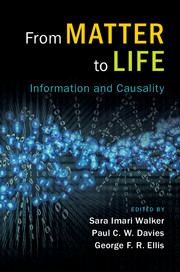1 - Introduction
Published online by Cambridge University Press: 02 March 2017
Summary
The concept of information has penetrated almost all areas of human inquiry, from physics, chemistry, and engineering through biology to the social sciences. And yet its status as a physical entity remains obscure. Traditionally, information has been treated as a derived or secondary concept. In physics especially, the fundamental bedrock of reality is normally vested in the material building blocks of the universe, be they particles, strings, or fields. Because bits of information are always instantiated in material degrees of freedom, the properties of information could, it seems, always be reduced to those of the material substrate. Nevertheless, over several decades there have been attempts to invert this interdependence and root reality in information rather than matter. This contrarian perspective is most famously associated with the name of John Archibald Wheeler, who encapsulated his proposal in the pithy dictum ‘it from bit?’ (Wheeler, 1999).
In a practical, everyday sense, information is often treated as a primary entity, as a ‘thing in its own right’ with a measure of autonomy; indeed, it is bought and sold as a commodity alongside gas and steel. In the life sciences, informational narratives are indispensable: biologists talk about the genetic code, about translation and transcription, about chemical signals and sensory data processing, all of which treat information as the currency of activity, the ‘oil’ that makes the ‘biological wheels go round’. The burgeoning fields of genomic and metagenomic sequencing and bioinformatics are based on the notion that informational bits are literally vital. But beneath this familiar practicality lies a stark paradox. If information makes a difference in the physical world, which it surely does, then should we not attribute to it causal powers? However, in physics causation is invariably understood at the level of particle and field interactions, not in the realm of abstract bits (or qubits, their quantum counterparts). Can we have both? Can two causal chains coexist compatibly? Are the twin narratives of material causation and informational causation comfortable bedfellows? If so, what are the laws and principles governing informational dynamics to place alongside the laws of material dynamics?
- Type
- Chapter
- Information
- From Matter to LifeInformation and Causality, pp. 1 - 16Publisher: Cambridge University PressPrint publication year: 2017
- 1
- Cited by



